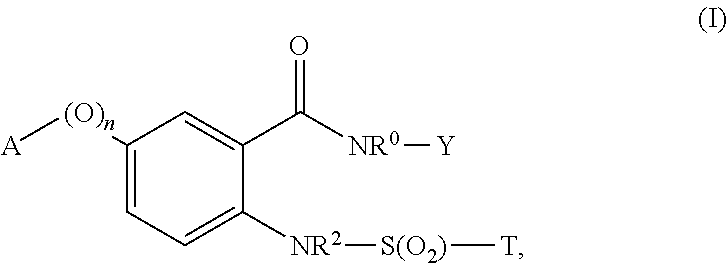Novel sulfonylaminobenzamide compounds as anthelmintics
a technology of sulfonylaminobenzamide and compounds, which is applied in the direction of antiparasitic agents, group 3/13 element organic compounds, drug compositions, etc., can solve the problems of time-consuming treatment, and inability to fully cur
- Summary
- Abstract
- Description
- Claims
- Application Information
AI Technical Summary
Benefits of technology
Problems solved by technology
Method used
Image
Examples
example 1a
Synthesis of 2-(methylsulfonamido)-5-morpholino-N-(3,4,5-trichlorophenyl)benzamide (Ex. 1.2 in Table 1)
Step A: 5-chloro-2-nitro-N-(3,4,5-trichlorophenyl) benzamide
[0134]5-chloro-2-nitrobenzoic acid (10 g) was treated with thionyl chloride (7.2 mL) at reflux for 4 h. Excess SOCl2 was removed under vacuum. CH2Cl2 (100 mL) was added to the acyl chloride. At 0° C., 3,4,5-trichloroaniline (9.7 g) and NEt3 (13.8 mL) in 100 mL CH2Cl2 were added slowly. The reaction mixture was allowed to warm up and it was stirred at rt (room temperature) overnight. The reaction mixture was diluted with 200 mL diethyl ether. 10 mL HCl 2 N and 200 mL H2O were added, and the mixture was stirred until a yellow precipitate is formed. The precipitate was filtered off and dried under high vacuum before analysis (yield: 66%). LCMS (method B): 380.59 (M+H)+ at 1.97 min.
Step B: 5-morpholino-2-nitro-N-(3,4,5-trichlorophenyl)benzamide
[0135]To a solution of 300 mg of 5-chloro-2-nitro-N-(3,4,5-trichlorophenyl)benzamide...
example 1b
N-(3,5-bis (trifluoromethyl) phenyl)-5-(2-fluoropyridin-3-yl)-2-(methylsulfonamido) benzamide (Ex. 1.14 in Table 1)
Step A: methyl 5-bromo-2-(methylsulfonamido) benzoate
[0138]A N2 degassed solution of methyl 2-amino-5-bromobenzoate (2.8 g) in 10 mL 1 pyridine was cooled to 0° C. before the drop wise addition of methane sulfonyl chloride (0.9 mL). The reaction mixture was stirred overnight at rt, then diluted with 50 mL ethyl acetate. The organic layer was washed with a saturated solution of Na2CO3, with brine, then dried over MgSO4 and evaporated to dryness (yield: 82%). LCMS (method B): 305.6 (M−H)− at 1.55 min.
Step B: 5-bromo-2-(methylsulfonamido)benzoic acid
[0139]Methyl 5-bromo-2-(methylsulfonamido) benzoate (3.15 g) was suspended in THF (20 mL, 1 / 1). NaOH 4 N (6.9 mL) was added and the reaction mixture was stirred 4 h at reflux. Upon completion, the reaction mixture was treated with 2N HCl (1 mL) and extracted twice with ethyl acetate. Combined organic layers were washed with H2O...
example 2
5-phenoxy-2-(phenylsulfonamido)-N-(3,4,5-trichlorophenyl)benzamide (Ex. 2.2 in Table 2)
Step A: 2-nitro-5-phenoxy-N-(3,4,5-trichlorophenyl)benzamide
[0146]5-Chloro-2-nitro-N-(3,4,5-trichlorophenyl) benzamide (29.1 g), K2CO3 (21.3 g) and phenol (8 g) in DMA were heated at 140° C. during 14 h. The reaction mixture was poured in H2O (100 mL), the precipitate was filtered off, dried under high vacuum to afford a brown solid (yield: 80%). LCMS (method B): 436.6 (M−H)− at 2.14 min.
Step B: 2-amino-5-phenoxy-N-(3,4,5-trichlorophenyl)benzamide
[0147]2-nitro-5-phenoxy-N-(3,4,5-trichlorophenyl)benzamide treated with iron in a similar manner as described for step C Example 1 (yield: 27%). LCMS (method B): 406.7 (M+H)+ at 2.28 min.
Step C: 5-(4-Chlorophenoxy)-2-(methylsulfonamido)-N-(3,4,5-trichlorophenyl) benzamide
[0148]To N2 degassed solution of 2-amino-5-phenoxy-N-(3,4,5-trichlorophenyl)benzamide (0.26 mg) in 2 mL of CH2Cl2, pyridine (0.25 mL) was added. The mixture was cooled to 0° C. before the...
PUM
 Login to View More
Login to View More Abstract
Description
Claims
Application Information
 Login to View More
Login to View More - R&D
- Intellectual Property
- Life Sciences
- Materials
- Tech Scout
- Unparalleled Data Quality
- Higher Quality Content
- 60% Fewer Hallucinations
Browse by: Latest US Patents, China's latest patents, Technical Efficacy Thesaurus, Application Domain, Technology Topic, Popular Technical Reports.
© 2025 PatSnap. All rights reserved.Legal|Privacy policy|Modern Slavery Act Transparency Statement|Sitemap|About US| Contact US: help@patsnap.com



